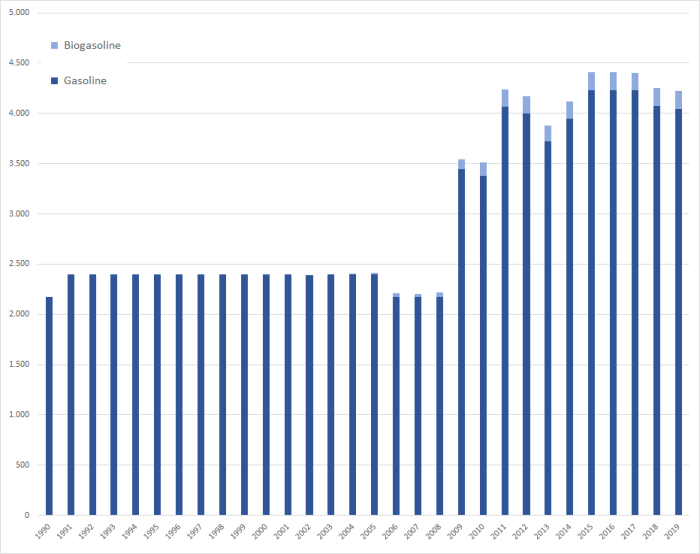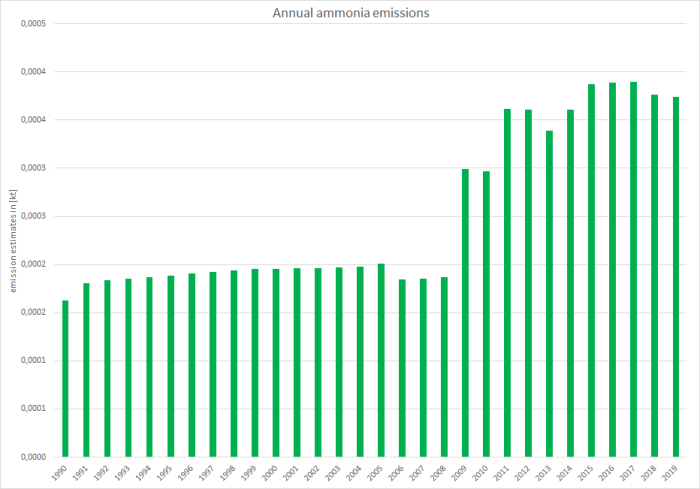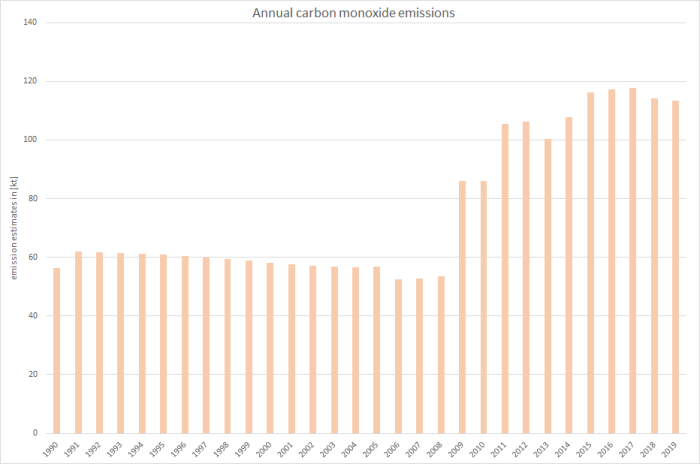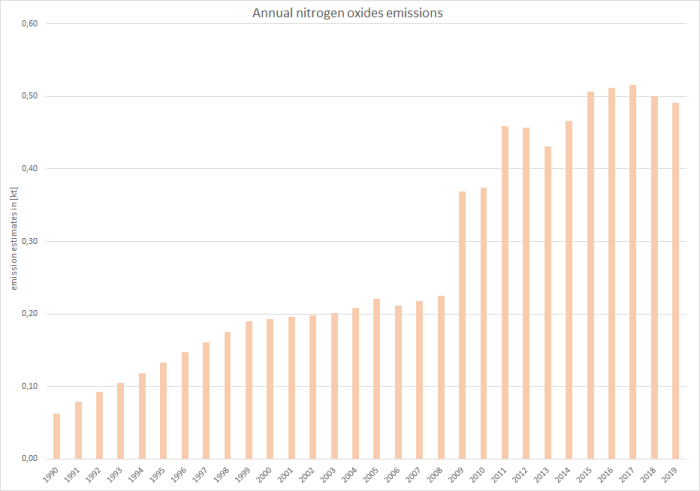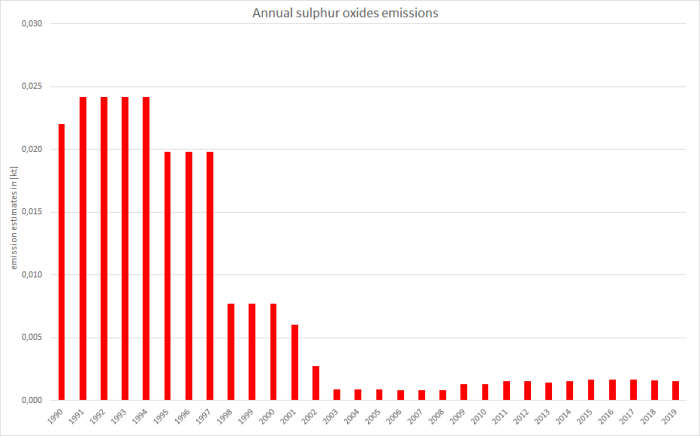meta data for this page
1.A.4.b ii - Residential: Household and Gardening: Mobile
Short description
Under sub-category 1.A.4.b ii - Residential: Mobile Sources in Households and Gardening  fuel combustion activities and resulting emissions from combustion engine driven devices such as motor saws and lawn mowers are being reported.
fuel combustion activities and resulting emissions from combustion engine driven devices such as motor saws and lawn mowers are being reported.
| Method | AD | EF | Key Category Analysis |
|---|---|---|---|
| T1, T2 | NS, M | CS, M, D | L/T: CO |
image Lawnmower.PNG size="small"
Methodology
Activity data
Activity data are taken from annual fuel delieveries data provided in line 66: 'Households' of the National Energy Balances (NEB) for Germany (AGEB, 2020) 1).
Table 1: Sources for consumption data in 1.A.4.b ii
| Relevant years | Data Source |
|---|---|
| through 1994 | AGEB - National Energy Balance, line 79: Households |
| since 1995 | AGEB - National Energy Balance, line 66: Households |
Here, given the rare statistics on sold machinery, these activity data is of limited quality only (no annual but cascaded trend).
As the NEB only provides primary activity data for total biomass used in 'households', but does not distinguish into specific biofuels, consumption data for bioethanol used in NFR 1.A.4.b ii are calculated by applying Germany's official annual shares of biogasoline blended to fossil gasoline.
Please note: Data on gasoline used in households as provided in the National Energy Balances represents a “residual item” following the allocation of the majority of this fuel to road and military vehicles. Here, fuel sales to road vehicles might also include gasoline acquired on filling stations but used for household equipment.
Due to these reasons, activity data for gasoline consumption in households machinery and, hence, several emission estimates show no realistic trend but a stepwise development with significant jumps.
Table 2: Annual over-all fuel deliveries to residential mobile sources, in terajoules
| 1990 | 1995 | 2000 | 2005 | 2010 | 2011 | 2012 | 2013 | 2014 | 2015 | 2016 | 2017 | 2018 | 2019 | |
| Gasoline | 2.177 | 2.395 | 2.395 | 2.395 | 3.379 | 4.069 | 3.995 | 3.720 | 3.946 | 4.228 | 4.228 | 4.228 | 4.070 | 4.046 |
|---|---|---|---|---|---|---|---|---|---|---|---|---|---|---|
| Biogasoline | 0 | 0 | 0 | 16 | 131 | 167 | 177 | 159 | 172 | 183 | 184 | 178 | 183 | 175 |
| Ʃ 1.A.4.b ii | 2.177 | 2.395 | 2.395 | 2.411 | 3.510 | 4.236 | 4.172 | 3.879 | 4.118 | 4.411 | 4.412 | 4.406 | 4.253 | 4.221 |
source: AGEB, 2020 2) and TREMOD MM 3)
These primary activity data can be distributed onto 2- and 4-stroke engines used in households via annual shares from Knörr et al. (2020b) 4).
Table 3: Annual shares of 2- and 4-stroke engines
| 1990 | 1995 | 2000 | 2005 | 2010 | 2011 | 2012 | 2013 | 2014 | 2015 | 2016 | 2017 | 2018 | 2019 | |
| 2-Stroke | 28,2 % | 49,7 % | 66,5 % | 69,6 % | 73,9 % | 74,5 % | 75,7 % | 76,4 % | 76,6 % | 76,8 % | 77,1 % | 77,2 % | 77,4 % | 77,5 % |
|---|---|---|---|---|---|---|---|---|---|---|---|---|---|---|
| 4-Stroke | 71,8 % | 50,3 % | 33,5 % | 30,4 % | 26,1 % | 25,5 % | 24,3 % | 23,6 % | 23,4 % | 23,2 % | 22,9 % | 22,8 % | 22,6 % | 22,5 % |
source: TREMOD MM 5)
Table 4: Resulting estimates for fuel consumption in 2- and 4-stroke engines, in terajoules
| 1990 | 1995 | 2000 | 2005 | 2010 | 2011 | 2012 | 2013 | 2014 | 2015 | 2016 | 2017 | 2018 | 2019 | |
| 2-stroke engines | ||||||||||||||
| Gasoline | 614 | 1.191 | 1.592 | 1.667 | 2.498 | 3.033 | 3.023 | 2.841 | 3.023 | 3.249 | 3.258 | 3.266 | 3.150 | 3.137 |
|---|---|---|---|---|---|---|---|---|---|---|---|---|---|---|
| Biogasoline | 0 | 0 | 0 | 11 | 97 | 124 | 134 | 122 | 131 | 141 | 142 | 138 | 142 | 135 |
| 4-stroke engines | ||||||||||||||
| Gasoline | 1.563 | 1.204 | 803 | 728 | 881 | 1.036 | 972 | 879 | 923 | 979 | 970 | 962 | 920 | 909 |
| Biogasoline | 0 | 0 | 0 | 5 | 34 | 42 | 43 | 38 | 40 | 42 | 42 | 41 | 41 | 39 |
| Ʃ 1.A.4.b ii | 2.177 | 2.395 | 2.395 | 2.411 | 3.510 | 4.236 | 4.172 | 3.879 | 4.118 | 4.411 | 4.412 | 4.406 | 4.253 | 4.221 |
Emission factors
The emission factors used here are of rather different quality: For all main pollutants, carbon monoxide and particulate matter, annually changing values computed within TREMOD-MM (Knörr et al. (2020b)) 6) are used, representing the development of mitigation technologies and the effect of fuel-quality legislation.
Here, as no such specific EF are available for biofuels, the values used for gasoline are applied to bioethanol, too.
For lead (Pb) from leaded gasoline and corresponding TSP emissions, additional emissions are are calculated from 1990 to 1997 based upon contry-specific emission factors from 7).)
Table 4: Annual country-specific emission factors from TREMOD MM1, in kg/TJ
| 1990 | 1995 | 2000 | 2005 | 2010 | 2011 | 2012 | 2013 | 2014 | 2015 | 2016 | 2017 | 2018 | 2019 | |
| 4-stroke machinery | ||||||||||||||
| NH3 | 0,09 | 0,09 | 0,09 | 0,09 | 0,09 | 0,09 | 0,09 | 0,09 | 0,09 | 0,09 | 0,09 | 0,09 | 0,09 | 0,09 |
|---|---|---|---|---|---|---|---|---|---|---|---|---|---|---|
| NMVOC2 | 475 | 1.289 | 1.604 | 1.651 | 1.647 | 1.646 | 1.645 | 1.643 | 1.641 | 1.638 | 1.635 | 1.632 | 1.628 | 1.624 |
| NMVOC3 | 727 | 819 | 809 | 783 | 774 | 771 | 769 | 767 | 765 | 763 | 762 | 761 | 760 | 756 |
| NOx | 51,0 | 85,3 | 103 | 108 | 122 | 124 | 126 | 129 | 131 | 132 | 133 | 134 | 135 | 133 |
| SOx | 10,1 | 8,27 | 3,22 | 0,37 | 0,37 | 0,37 | 0,37 | 0,37 | 0,37 | 0,37 | 0,37 | 0,37 | 0,37 | 0,37 |
| BC5 | 0,31 | 0,27 | 0,24 | 0,23 | 0,24 | 0,25 | 0,25 | 0,25 | 0,26 | 0,26 | 0,26 | 0,26 | 0,26 | 0,26 |
| PM4 | 6,29 | 5,46 | 4,85 | 4,62 | 4,87 | 4,94 | 5,00 | 5,06 | 5,11 | 5,15 | 5,19 | 5,22 | 5,24 | 5,25 |
| CO | 39.998 | 32.154 | 28.346 | 27.161 | 27.992 | 28.278 | 28.555 | 28.813 | 29.047 | 29.249 | 29.418 | 29.548 | 29.647 | 29.614 |
| 2-stroke machinery | ||||||||||||||
| NH3 | 0,07 | 0,07 | 0,07 | 0,07 | 0,07 | 0,08 | 0,08 | 0,08 | 0,09 | 0,09 | 0,09 | 0,09 | 0,09 | 0,09 |
| NMVOC2 | 6.126 | 5.914 | 5.879 | 5.816 | 5.835 | 5.372 | 4.327 | 3.635 | 3.473 | 3.315 | 3.164 | 3.024 | 2.900 | 2.796 |
| NMVOC3 | 1.387 | 1.129 | 510 | 392 | 280 | 288 | 305 | 317 | 321 | 325 | 328 | 331 | 334 | 335 |
| NOx | 19,8 | 25,7 | 36,3 | 53,4 | 63,8 | 61,9 | 57,1 | 55,0 | 55,9 | 56,8 | 57,5 | 58,2 | 58,7 | 59,2 |
| SOx | 10,10 | 8,27 | 3,22 | 0,37 | 0,37 | 0,37 | 0,37 | 0,37 | 0,37 | 0,37 | 0,37 | 0,37 | 0,37 | 0,37 |
| BC5 | 6,91 | 6,14 | 5,13 | 4,93 | 4,79 | 4,93 | 5,22 | 5,41 | 5,49 | 5,55 | 5,61 | 5,67 | 5,71 | 5,75 |
| PM4 | 138 | 123 | 103 | 99 | 96 | 99 | 104 | 108 | 110 | 111 | 112 | 113 | 114 | 115 |
| CO | 20.270 | 18.743 | 16.255 | 15.483 | 14.699 | 15.068 | 15.891 | 16.438 | 16.618 | 16.797 | 16.967 | 17.125 | 17.266 | 17.385 |
| 2- and 4-stroke machinery | ||||||||||||||
| TSP6 | 2,35 | 0,82 | ||||||||||||
| Pb | 1,47 | 0,52 | ||||||||||||
1 due to lack of better information: similar EF are applied for fossil and biofuels
2 from fuel combustion
3 from gasoline evaporation
4 EF(PM2.5) also applied for PM10 and TSP (assumption: > 99% of TSP consists of PM2.5)
5 estimated via a f-BCs as provided in 8), Chapter 1.A.2.g vii, 1.A.4.a ii, b ii, c ii, 1.A.5.b i - Non-road, note to Table 3-1: Tier 1 emission factors for off-road machinery
6 from leaded gasoline (until 1997)
With respect to the emission factors applied for particulate matter, given the circumstances during test-bench measurements, condensables are most likely included at least partly. 9)
For lead (Pb) from leaded gasoline and corresponding TSP emissions, additional emissions are are calculated from 1990 to 1997 based upon contry-specific emission factors from 10).
NOTE: For the country-specific emission factors applied for particulate matter, no clear indication is available, whether or not condensables are included.
For information on the emission factors for heavy-metal and POP exhaust emissions, please refer to Appendix 2.3 - Heavy Metal (HM) exhaust emissions from mobile sources and Appendix 2.4 - Persistent Organic Pollutant (POP) exhaust emissions from mobile sources.
Discussion of emission trends
Table: Outcome of Key Category Analysis
| for: | CO |
|---|---|
| by: | Level & Trend |
Given the limited quality of gasoline-deliveries data from NEB line 66, the following emission trends are of limited significance only.
Unregulated pollutants (Ammonia, HMs, POPs, ...)
For all unregulated pollutants, emission trends directly follow the trend in fuel consumption.
Here, as the emission factors for heavy metals (and POPs) are derived from tier1 default values, the emission's trend is stronlgy influenced by the share of 2-stroke gasoline fuel (containing lube oil with presumably higher HM content) consumed.
Regulated pollutants
For all regulated pollutants, emission trends follow not only the trend in fuel consumption but also reflect the impact of fuel-quality and exhaust-emission legislation. However, especially for CO and NOx, trends are strongly influenced by the changes in annual fuel deliveries as provided in NEB line 66.
Particulate matter
Over-all PM emissions are by far dominated by emissions from diesel oil combustion with the falling trend basically following the decline in fuel consumption between 2000 and 2005. Nonetheless, the decrease of the over-all emission trend was and still is amplified by the expanding use of particle filters especially to eliminate soot emissions.
Additional contributors such as the impact of TSP emissions from the use of leaded gasoline (until 1997) have no significant effect onto over-all emission estimates.
Here, as the EF(BC) are estimated via fractions provided in 11), black carbon emissions follow the corresponding emissions of PM2.5.
Recalculations
Primary activity data fro NEB line 66 remains unrevised. However, the percental shares of 2- and 4-stroke engines have been revised according to TREMOD MM.
Table 5: Revised annual shares of 2- and 4-stroke engines
| 1990 | 1995 | 2000 | 2005 | 2010 | 2011 | 2012 | 2013 | 2014 | 2015 | 2016 | 2017 | 2018 | |
| 2-stroke machinery | |||||||||||||
| Submission 2021 | 0,282 | 0,497 | 0,665 | 0,696 | 0,739 | 0,745 | 0,757 | 0,764 | 0,766 | 0,768 | 0,771 | 0,772 | 0,774 |
|---|---|---|---|---|---|---|---|---|---|---|---|---|---|
| Submission 2020 | 0,282 | 0,497 | 0,665 | 0,687 | 0,728 | 0,734 | 0,745 | 0,752 | 0,755 | 0,757 | 0,759 | 0,761 | 0,763 |
| absolute change | 0,000 | 0,000 | 0,000 | 0,009 | 0,011 | 0,012 | 0,012 | 0,012 | 0,012 | 0,011 | 0,011 | 0,011 | 0,011 |
| relative change | 0,00% | 0,00% | 0,00% | 1,28% | 1,57% | 1,61% | 1,58% | 1,55% | 1,54% | 1,52% | 1,49% | 1,49% | 1,48% |
| 4-stroke machinery | |||||||||||||
| Submission 2021 | 0,718 | 0,503 | 0,335 | 0,304 | 0,261 | 0,255 | 0,243 | 0,236 | 0,234 | 0,232 | 0,229 | 0,228 | 0,226 |
| Submission 2020 | 0,718 | 0,503 | 0,335 | 0,313 | 0,272 | 0,266 | 0,255 | 0,248 | 0,245 | 0,243 | 0,241 | 0,239 | 0,237 |
| absolute change | 0,000 | 0,000 | 0,000 | -0,009 | -0,011 | -0,012 | -0,012 | -0,012 | -0,012 | -0,011 | -0,011 | -0,011 | -0,011 |
| relative change | 0,00% | 0,00% | 0,00% | -2,81% | -4,19% | -4,44% | -4,62% | -4,70% | -4,73% | -4,72% | -4,70% | -4,76% | -4,77% |
Table 5: Resulting revised annual fuel consumptions of 2- and 4-stroke engines
| 1990 | 1995 | 2000 | 2005 | 2010 | 2011 | 2012 | 2013 | 2014 | 2015 | 2016 | 2017 | 2018 | |
| 2-stroke machinery | |||||||||||||
| Submission 2021 | 1.563 | 1.204 | 803 | 733 | 915 | 1.078 | 1.015 | 917 | 963 | 1.021 | 1.012 | 1.003 | 961 |
|---|---|---|---|---|---|---|---|---|---|---|---|---|---|
| Submission 2020 | 1.563 | 1.204 | 803 | 754 | 955 | 1.128 | 1.065 | 962 | 1.010 | 1.072 | 1.062 | 1.053 | 1.009 |
| absolute change | 0,00 | 0,00 | 0,00 | -21,2 | -40,0 | -50,1 | -49,1 | -45,3 | -47,7 | -50,6 | -49,9 | -50,1 | -48,1 |
| relative change | 0,00% | 0,00% | 0,00% | -2,81% | -4,19% | -4,44% | -4,62% | -4,70% | -4,73% | -4,72% | -4,70% | -4,76% | -4,77% |
| 4-stroke machinery | |||||||||||||
| Submission 2021 | 614 | 1.191 | 1.592 | 1.679 | 2.594 | 3.158 | 3.157 | 2.963 | 3.155 | 3.390 | 3.399 | 3.404 | 3.292 |
| Submission 2020 | 614 | 1.191 | 1.592 | 1.658 | 2.554 | 3.108 | 3.108 | 2.917 | 3.107 | 3.340 | 3.349 | 3.354 | 3.244 |
| absolute change | 0,00 | 0,00 | 0,00 | 21,20 | 40,03 | 50,09 | 49,13 | 45,26 | 47,74 | 50,63 | 49,89 | 50,11 | 48,11 |
| relative change | 0,00% | 0,00% | 0,00% | 1,28% | 1,57% | 1,61% | 1,58% | 1,55% | 1,54% | 1,52% | 1,49% | 1,49% | 1,48% |
In addition, several annual country-specific emission factors have been revised accoring to changes within TREMOD but cannot be displayed here in a comprehendible way.
For pollutant-specific information on recalculated emission estimates for Base Year and 2018, please see the pollutant specific recalculation tables following chapter 8.1 - Recalculations.
Uncertainties
Uncertainty estimates for activity data of mobile sources derive from research project FKZ 360 16 023 (Knörr et al. (2009)) 12): “Ermittlung der Unsicherheiten der mit den Modellen TREMOD und TREMOD-MM berechneten Luftschadstoffemissionen des landgebundenen Verkehrs in Deutschland”.
Uncertainty estimates for emission factors were compiled during the PAREST research project. Here, the final report has not yet been published.
Planned improvements
Besides a routine revision of the TREMOD MM model, no specific improvements are planned.
FAQs
Why are similar EF applied for estimating exhaust heavy metal emissions from both fossil and biofuels?
The EF provided in 13) represent summatory values for (i) the fuel's and (ii) the lubricant's heavy-metal content as well as (iii) engine wear. Here, there might be no heavy metal contained in biofuels. But since the specific shares of (i), (ii) and (iii) cannot be separated, and since the contributions of lubricant and engine wear might be dominant, the same emission factors are applied to biodiesel and bioethanol.


